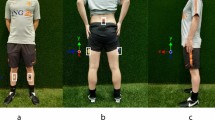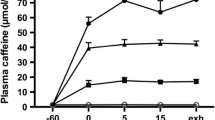Abstract
We monitored gas exchange and muscle activity during two commonly used modes of passive leg exercise as a means of assessing the degree of passivity associated with these techniques. Additionally, we measured the rapid changes in ventilation at the start and end of the passive exercise to assess changes that occur in the fast exercise drive to breathe during passive exercise. We monitored seven subjects at rest and during 5 min of passive exercise using (1) cycling movements performed on a tandem bicycle and (2) leg extension movements performed in a chair apparatus. The increase in measured parameters from rest to passive exercise were all higher while using the tandem bicycle compared to the chair apparatus: ventilation [3.09 (0.63) versus 0.35 (0.38) l·min−1], leg muscle electromyogram [8.3 (1.6) versus 1.6 (0.6) μV], carbon dioxide production [0.092 (0.018) versus −0.002 (0.001) l·min−1] and oxygen consumption [0.158 (0.046) versus −0.008 (0.007) l·min−1]. Passive exercise on the tandem bicycle was also associated with a significantly larger fast exercise drive to breathe at both the start and end of motion, compared to the chair apparatus [start: 5.59 (0.74) versus 3.08 (0.79) l·min−1, end: 3.38 (0.79) versus 1.75 (0.54) l·min−1]. The fast exercise drive to breathe at the end of exercise was significantly smaller (60%) than at the start for both modes. We conclude that passive exercise on an upright bicycle contains a significant active component that contributes both neural and metabolic influences toward the physiological adjustments observed. Furthermore, we conclude that adaptation occurs in the fast exercise drive to breathe accompanying passive limb movement.





Similar content being viewed by others
References
Bahnson ER, Horvath SM, Comroe JH (1949) Effects of active and "passive" limb movements upon respiration and O2 consumption in man. J Appl Physiol 2:169–173
Benjamin FB, Peyser L (1964) Physiological effects of active and passive exercise. J Appl Physiol 19:1212–1214
Comroe JH, Schmidt CF (1943) Reflexes from the limbs as a factor in the hyperpnea of muscular exercise. Am J Physiol 138:536–547
De Meersman R, Zion A, Weir J, Lieberman J, Downey J (1998) Mechanoreceptors and autonomic responses to movement in humans. Clin Auton Res 8:201–205
Dejours P (1964) Control of respiration in muscular exercise. In: Fenn WO, Rahn H (eds) Handbook of physiology, section 3, vol I, chapter 25. American Physiological Society, Washington DC, pp 631–648
Dejours P (1967) Neurogenic factors in the control of ventilation during exercise. Circ Res 146–153
Dixon ME, Stewart PB, Mills FC, Varvis CJ, Bates DV (1961) Respiratory consequences of passive body movements. J Appl Physiol 16:30–34
Duffin J (1994) Neural drives to breathing during exercise. Can J Appl Physiol 19:289–304
Eldridge FL, Waldrop TG (1991) Neural control of breathing during exercise. In: Whipp BJ, Wasserman K (eds) Exercise: pulmonary physiology and pathophysiology. Marcel Dekker, New York, pp 309–370
Gray JS (1946) The multiple factor theory of the control of respiratory ventilation. Science 103:739–744
Harrison TR, Harrison WG, Calhoun JA, Marsh JP (1932) Congestive heart failure. The mechanism of dyspnea on exertion. Arch Int Med 50:690–720
Ishida K, Yasuda Y, Miyamura M (1992) Ventilatory response at the onset of passive exercise during sleep in man. In: Honda Y, Miyamoto Y, Konno K, Widdicombe JG (eds) Control of breathing and its modelling perspectives. Plenum, New York, pp 275–278
Ishida K, Yasuda Y, Miyamura M (1993) Cardiorespiratory response at the onset of passive leg movements during sleep in humans. Eur J Appl Physiol 66:507–513
Ishida K, Takaishi T, Miyamura M (1994) Ventilatory responses at the onset of passive movement and voluntary exercise with arms and legs. Acta Physiol Scand 151:343–352
Ishida K, Hayashi T, Moritani T, Miyamura M (1997) Effects of combined beta-adrenergic and cholinergic blockade on the initial ventilatory response to exercise in humans. Eur J Appl Physiol 76:230–235
Ishida K, Sato Y, Katayama K, Miyamura M (2000) Initial ventilatory and circulatory responses to dynamic exercise are slowed in the elderly. J Appl Physiol 89:1771–1777
Kao FF (1977) The peripheral neurogenic drive: an experimental study. In: Dempsey JA, Deed CE (eds) Muscular exercise and the lung. University of Wisconson Press, Madison, Wis., pp 71–85
Kaufman MP, Forster HV (1996) Reflexes controlling circulatory, ventilatory and airway responses to exercise. In: Rowell LB, Shepherd JT (eds) Handbook of physiology, section 12, chapter 10. Oxford University Press, Oxford, pp 381–447
Koehle M, Duffin J (1996) The effect of exercise duration on the fast component of exercise hyperpnoea at work rates below the first ventilatory threshold. Eur J Appl Physiol 74:548–552
Krzeminski K, Kruk B, Nazar K, Ziemba AW, Cybulski G, Niewiadomski W (2000) Cardiovascular, metabolic and plasma catecholamine responses to passive and active exercises. J Physiol Pharmacol 51:267–278
Mateika JH, Duffin J (1992) Changes in ventilation at the start and end of moderate and heavy exercise of short and long duration. Eur J Appl Physiol 65:234–240
Mateika JH, Duffin J (1994) Ventilatory responses to exercise performed below and above the first ventilatory threshold. Eur J Appl Physiol 68:327–335
Matell G (1963) Time-courses of changes in ventilation and arterial gas tensions in man induced by moderate exercise. Acta Physiol Scand 58:1–53
Miyamura M (1994) Control of ventilation during exercise in man with special reference to the feature at the onset. Jpn J Physiol 44:123–139
Miyamura M, Ishida K, Hashimoto I, Yuza N (1997) Ventilatory response at the onset of voluntary exercise and passive movement in endurance runners. Eur J Appl Physiol 76:221–229
Morikawa T, Ono Y, Sasaki K, Sakakibara Y, Tanaka Y, Maruyama R, Nishibayashi Y, Honda Y (1989) Afferent and cardiodynamic drives in the early phase of exercise hyperpnea in humans. J Appl Physiol 67:2006–2013
Nobrega AC, Araujo CG (1993) Heart rate transient at the onset of active and passive dynamic exercise. Med Sci Sports Exerc 25:37–41
Nobrega AC, Williamson JW, Friedman DB, Araujo CG, Mitchell JH (1994) Cardiovascular responses to active and passive cycling movements. Med Sci Sports Exerc 26:709–714
Otis AB (1949) Application of Gray's theory of respiratory control to the hyperpnoea produced by passive movements of the limbs. J Appl Physiol 1:743–751
Sato Y, Katayama K, Ishida K, Miyamura M (2000) Ventilatory and circulatory responses at the onset of voluntary exercise and passive movement in children. Eur J Appl Physiol 83:516–523
Scott AC, Francis DP, Davies LC, Ponikowski P, Coats AJ, Piepoli MF (2000) Contribution of skeletal muscle "ergoreceptors" in the human leg to respiratory control in chronic heart failure. J Physiol (Lond) 529:863–870
Turker KS (1993) Electromyography: some methodological problems and issues. Phys Ther 73:698–710
Waisbren SJ, Whiting CS, Nadel ER (1990) Effects of passive limb movement on pulmonary ventilation. Yale J Biol Med 63:549–556
Waldrop TG, Eldridge FL, Iwamoto GA, Mitchell JH (1996) Central neural control of respiration and circulation during exercise. In: Rowell LB, Shepherd JT (eds) Handbook of physiology. Oxford University Press, New York, pp 333–380
Acknowledgements
The Ontario Thoracic Society supported this work. H.B. is the recipient of a Toronto Rehabilitation Institute Student Scholarship.
Author information
Authors and Affiliations
Corresponding author
Rights and permissions
About this article
Cite this article
Bell, H.J., Ramsaroop, D.M. & Duffin, J. The respiratory effects of two modes of passive exercise. Eur J Appl Physiol 88, 544–552 (2003). https://doi.org/10.1007/s00421-002-0771-5
Accepted:
Published:
Issue Date:
DOI: https://doi.org/10.1007/s00421-002-0771-5




